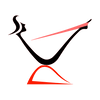How well your shoulder is functioning is dependent on the health of your rotator cuff. Most people never think about exercising their rotator cuff, however, they should!
If the rotator cuff is not functioning well it sets the stage for tendonitis and other dysfunctions. This is because the rotator cuff fine tunes the movements of the shoulder. The deltoids, biceps, triceps and lats do the large powerful movements of the arm such as lifting, pushing and pulling. For these movements to occur without pinching of sensitive structures inside the shoulder joint, it is necessary to have a well functioning rotator cuff. The rotator cuff works to pull the top of the arm bone down as the arm lifts over head. If this were not to occur, the top of the arm would jam into the bones of the shoulder joint.
Did you know that the rotator cuff is not one muscle but four muscles?
The rotator cuff muscles are found on the shoulder blade and attach to the upper arm bone. The muscles of the rotator cuff are the suprapspinatus (usually the part of the rotator cuff that tears), infraspinatus, teres minor and subscapularis. The first three muscles work together to rotate the arm outward. The last muscle (the subscapularis) rotates the arm inward.
If you have a resistance band, you can do a simple exercise that will strengthen your rotator cuff. Grasp your band, palm up. Position your bent elbows at your waistline. Make sure your chest is open - feel like your collarbones are long (work for the best possible posture). Maintain your elbows at your waistline as you rotate your arms outward. Make sure to keep your forearms parallel to the floor as you do this movement. The pictures below demonstrates the start and end positions of this exercise.

With the PILATES MiniMAX you are able to do an advanced version of this exercise. This exercise is more difficult because you maintain your arm lifted as you rotate the arm. The pictures below demonstrate the start and end position of this advanced exercise.



